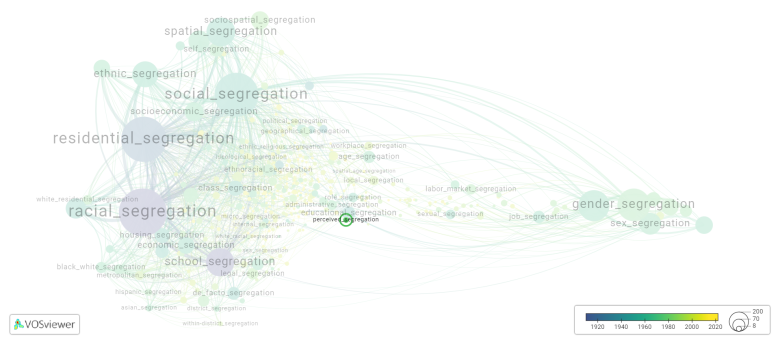Perceived segregation
Date and country of first publication[1]
1987
United States
Definition
Perceived segregation refers to an individual's beliefs or observations about the separation of different social or ethnic groups within a particular community or society. This segregation may be based on factors such as race, ethnicity, religion, socioeconomic status, or other characteristics. Perceived segregation can have a significant impact on individuals' experiences and interactions within a community, influencing their sense of belonging, access to resources, and overall quality of life. It can also contribute to social inequalities and perpetuate discriminatory attitudes and behaviors.
See also
Related segregation forms
Perceived segregation is frequently discussed in the literature with the following segregation forms:
population segregation,perceived school segregation

For the complete network of associated segregation forms, see:
clusters https://tinyurl.com/2d8wg5n3
year of publication https://tinyurl.com/2235lkhw
betweenness centrality https://tinyurl.com/223udk5r
disciplines where segregation forms first appeared https://tinyurl.com/244d8unz
References
Notes
- ↑ Date and country of first publication as informed by the Scopus database (December 2023).
At its current state, this definition has been generated by a Large Language Model (LLM) so far without review by an independent researcher or a member of the curating team of segregation experts that keep the Segregation Wiki online. While we strive for accuracy, we cannot guarantee its reliability, completeness and timeliness. Please use this content with caution and verify information as needed. Also, feel free to improve on the definition as you see fit, including the use of references and other informational resources. We value your input in enhancing the quality and accuracy of the definitions of segregation forms collectively offered in the Segregation Wiki ©.
Perceived segregation appears in the following literature
Parmelee P.A. (1987). Sex role identity, role performance and marital satisfaction of newly wed couples. Journal of Social and Personal Relationships, 4(4), 429-444. https://doi.org/10.1177/0265407587044003
Beck J., Rosenfeld A., Ivry R. (1989). Line Segregation. Spatial Vision, 4(2-3), 75-101. https://doi.org/10.1163/156856889X00068
Sutter A., Beck J., Graham N. (1989). Contrast and spatial variables in texture segregation: Testing a simple spatial frequency channels model. Perception & Psychophysics, 46(4), 312-332. https://doi.org/10.3758/BF03204985
Beck J., Graham N., Sutter A. (1991). Lightness differences and the perceived segregation of regions and populations. Perception & Psychophysics, 49(3), 257-269. https://doi.org/10.3758/BF03214310
Cleary P.D., McMullen W., Fahs M.C., Muller C., Foley M., Stein E., Fulop G., Strain J., Sacks H.S. (1992). Using patient reports to assess hospital treatment of persons with AIDS: A pilot study. AIDS Care, 4(3), 325-332. https://doi.org/10.1080/09540129208253102
Beck J. (1994). Interference in the perceived segregation of equal luminance element arrangement texture patterns. Perception & Psychophysics, 56(4), 424-430. https://doi.org/10.3758/BF03206734
Oddo S., Beck J., Mingolla E. (1999). Texture segregation in chromatic element arrangement patterns. Spatial Vision, 12(4), 421-459. VSP BV.https://doi.org/10.1163/156856899X00247
Masin S.C. (2003). Effects of partial occlusion on perceived surface segregation. Perception, 32(10), 1189-1198. Pion Limited.https://doi.org/10.1068/p3382
Pritchard K., Symon G. (2011). Identity on the line: Constructing professional identity in a HR call centre. Work, Employment and Society, 25(3), 434-450. SAGE Publications Ltd.https://doi.org/10.1177/0950017011407970
Baysu G., de Valk H. (2012). Navigating the school system in Sweden, Belgium, Austria and Germany: School segregation and second generation school trajectories. Ethnicities, 12(6), 776-799. https://doi.org/10.1177/1468796812450857
